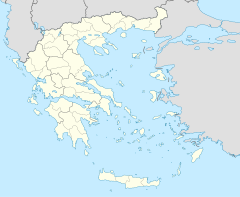|
Kalambaka railway station
Kalambaka railway station (Greek: Σιδηροδρομικός σταθμός Καλαμπάκας, romanized: Sidirodromikós stathmós Kalambákas) is the main railway station in Kalabaka, in the Trikala regional unit, Thessaly. Opened on 16 June 1886[3] by the Thessaly Railways (now part of OSE) as its first terminal station. Today Hellenic Train operates Regional Express services to destinations across Greece. It is currently the most northwesterly part of the Greek railway network in operation. HistoryThe station opened on 16 June 1886 as a terminus of Thessaly Railways.[4] The original station building (and the line) was designed by the Italian Evaristo de Chirico, (father of Giorgio de Chirico). The line was authorised by the Greek government under law AMH’/22.6.1882.[5] soon after the liberation of Central Greece from the Ottomans. After the First World War, the Greek state planned the ambitious construction of several new rail lines and links, including a standard gauge line from Kalambaka onto Kozani and then Veroia creating a conversion of the route from Volos to Kalambaka on standard gauge. In 1927, the relevant decisions were made; starting in 1928, work was carried out on the construction of the new line from Kalambaka. But a year later, it was clear that the project would exceed the estimated costs many times over. In 1932, the construction work was stopped and remains unfinished.[6] In 1955 Thessaly Railways was absorbed into Hellenic State Railways (SEK).[5] Freight traffic declined sharply when the state-imposed monopoly of OSE for the transport of agricultural products and fertilisers ended in the early 1990s. Many small stations of the network with little passenger traffic were closed down, especially on the mainline section and between Karditsa and Kalampaka. In 2001 the section between Kalampaka and Palaiofarsalos was converted from narrow gauge (1000 mm) to standard gauge (1435 mm) and physically connected at Palaiofarsalos with the mainline from Athens to Thessaloniki.[7] Since the upgrade, travel times have improved and the unification of rail gauge allowed direct services, even InterCity services, to link Volos and Kalambaka with Athens and Thessaloniki. In 2001 the infrastructure element of OSE was created, known as GAIAOSE. It would henceforth be responsible for the maintenance of stations, bridges and other network elements, as well as the leasing and the sale of railway assets.[1] In 2005, TrainOSE was created as a brand within OSE to concentrate on rail services and passenger interfaces. In 2009, with the Greek debt crisis unfolding OSE's Management was forced to reduce services across the network. Timetables were cut back, and routes closed as the government-run entity attempted to reduce overheads. In 2015 a 15-year-old child was airlifted to a hospital after being electrocuted at the station.[8] In 2017 OSE's passenger transport sector was privatised as TrainOSE, currently, a wholly-owned subsidiary of Ferrovie dello Stato Italiane[9] infrastructure, including stations, remained under the control of OSE. In July 2022, the station began being served by Hellenic Train, as the rebranded TranOSE.[10] On the 5 September 2023, Storm Daniel[11] triggered largescale flooding in Thessaly. The rail infrastructure was badly affected in the region, cutting on both Regional and Intercity routes[12] as significant parts of the infrastructure were washed away.[13] OSE engineers were on the ground in the worst affected areas Domokos, Doxaras, and Paleofarsalos to assess the extent of the damage, and prepare detailed reports, and seek financial assistance from the European Union.[14] 50 km (31 mi) of tracks was completely destroyed[15] Repairing the extensive damage, was estimated at between 35 and 45 million euros.[16] OSE managing director, Panagiotis Terezakis, spoke of reconstruction works reaching 50 million euros, confirming at the same time that there will be no rail traffic in the effected sections of the network for at least a month.[17] The devastation goes beyond the tracks and signalling, affecting costly equipment such as the European Train Control System (ETCS), which enhances rail safety.[18] The line from Palaiofarsalos–Kalambaka was damaged, with extensive work needed to repair the line and resume services[19] As a result services between Palaiofarsalos and Kalambaka remain suspended across Thessaly’s coast until the track is repaired, with a rail-replacement bus in operation.[20] NameIn modern Greek, MP is transliterated as B, not as MB and not as MP. That shows on the station sign and also on beer labels (MPYRA). FacilitiesThe station has waiting rooms on platform 1. There is a footbridge from platform 1 to platform 2, via stairs or lift. Luggage storage is no longer available; however, the station is staffed with ticket-purchasing facilities. Services
The station is served by fourteen local trains between Larissa and Volos. Today, the station is served by direct lines to the rest of Greece via Palaiofarsalos, served both by intercity trains to Athens, Palaiofarsalos Larissa and Thessaloniki.[21] Previously Thessaly Railways operated a narrow gauge service to Volos.[22] In August 2009, TrainOSE S.A. proceeded with a drastic cutback of passenger services on Thessaly lines.[23] As of spring 2020, there are ten (five in each direction) regional services on Palaiofarsalos-Kalambaka Line. In addition, there is one regional train to Athens from Kalambaka and back (884/885). Future plansAn extension towards Ioannina and Igoumenitsa has been discussed, but a more northern line from Thessaloniki is currently the preferred trajectory of the so-called Egnatia Railway. However, as of 2020, large investments are unlikely, given the prolonged Greek government-debt crisis.
Gallery
References
External linksWikimedia Commons has media related to Kalambaka train station. |
|||||||||||||||||||||||||||||||||||||||||||||||||||||||||||||||||||||||||||||||||||||||||||||||||||||||||||||||||||||||||||||||||||||||||||||||||||||||||||||||||||||||||||||||||||||||








